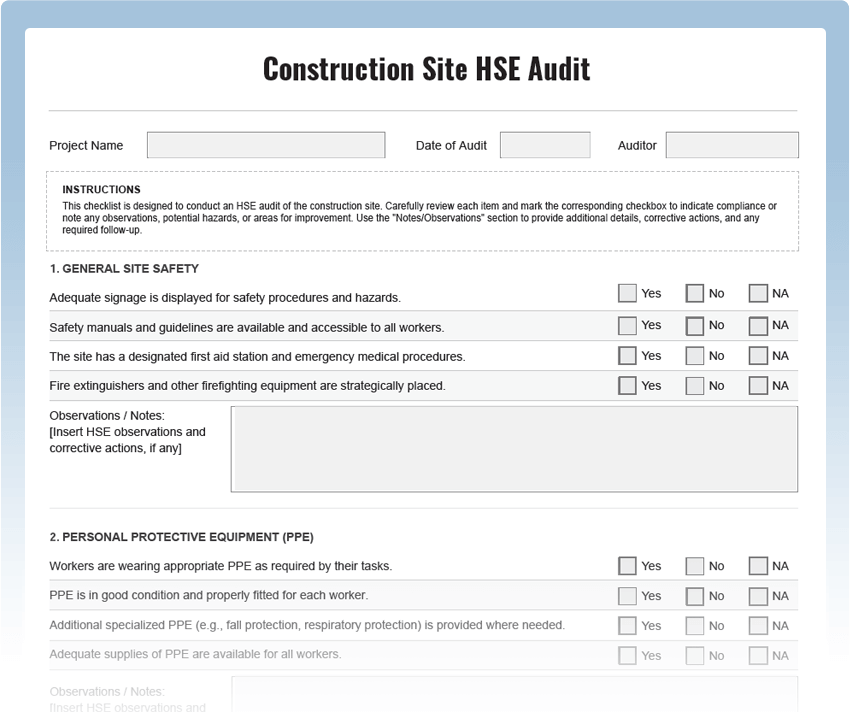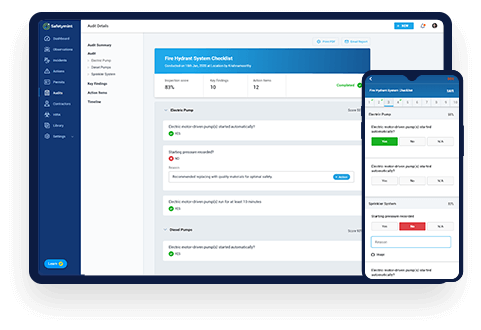Construction HSE Inspection Checklist
Promote a culture of safety and compliance on your construction site with our comprehensive Construction HSE Inspection Checklist. This free PDF template is designed to help you systematically assess Health, Safety, and Environmental (HSE) practices and identify potential hazards, ensuring a secure working environment for all construction personnel.
Digitize this Checklist on Safetymint
- Create unlimited, customized checklists
- Add Actions, with automated reminders
- Works seamlessly with or without internet
- Access via web browsers, mobile or tablets

What is a Construction HSE Inspection Checklist?
A Construction HSE Inspection Checklist is a systematic tool used to conduct safety inspections at construction sites. It includes a series of checkpoints designed to evaluate compliance with HSE regulations and best practices. Regular inspections are vital to prevent accidents, reduce injuries, and uphold environmental stewardship.
Key Areas to Inspect in Construction HSE:
- Personal Protective Equipment (PPE): Ensure workers are equipped with appropriate PPE, including hard hats, gloves, safety glasses, and high-visibility vests.
- Fall Protection: Inspect the availability and proper use of harnesses, guardrails, and safety nets to prevent falls from heights.
- Scaffolding and Ladders: Check the stability and proper assembly of scaffolding and ladders used on the construction site.
- Electrical Safety: Assess electrical wiring, outlets, and equipment to prevent electrical hazards.
- Excavation Safety: Ensure that excavations have proper shoring, sloping, or shielding to prevent collapse.
- Heavy Equipment Operation: Verify that operators are trained and qualified to operate heavy machinery safely.
- Hazardous Materials Handling: Observe the proper storage, handling, and disposal of hazardous materials on-site.
- Emergency Preparedness: Assess the availability and awareness of emergency response plans and equipment.
Common Construction HSE Hazards:
Construction sites can present various hazards, including:
- Falls from Heights: Inadequate fall protection can lead to severe injuries or fatalities.
- Electrical Accidents: Contact with live wires or faulty electrical equipment can cause electrocution.
- Struck-by Incidents: Workers may be struck by falling objects or moving construction equipment.
- Trenching and Excavation Hazards: Collapses can occur in improperly supported excavations.
- Hazardous Materials Exposure: Mishandling or improper storage of hazardous materials can lead to health risks.
Construction HSE Inspection Best Practices:
- Regular Inspections: Conduct frequent HSE inspections to identify and address potential risks promptly.
- Training and Education: Provide comprehensive HSE training to all construction personnel.
- Incident Reporting: Encourage a culture of reporting near misses and incidents for continuous improvement.
- Documentation and Recordkeeping: Maintain detailed records of inspections, incidents, and corrective actions taken.
- Collaboration: Involve workers and supervisors in the inspection process to enhance safety ownership.




